Sedum false - ground cover plants for the garden
Sedum false - a great option for design solutions on a personal plot. The plant is unpretentious in nature and does not require careful maintenance. Due to its high decorativeness, it allows you to easily create chic compositions in the garden. Often planted in pots on terraces or as a living roof cover. Also used for fixing multi-level flower beds.
- Description of the plant
- Varieties
- Tricolor
- Roseum
- Purple carpet
- Dragons blood
- Voodoo
- Albiflorum
- Fuldaglut
- Purchase and adaptation
- The necessary conditions
- Temperature
- Lighting
- Humidity
- Landing rules
- Site and soil selection
- Care
- Watering
- Top dressing
- Transfer
- Pruning
- Reproduction methods
- By cuttings
- Seeds
- By dividing the bush
- Diseases and pests
- Useful videos
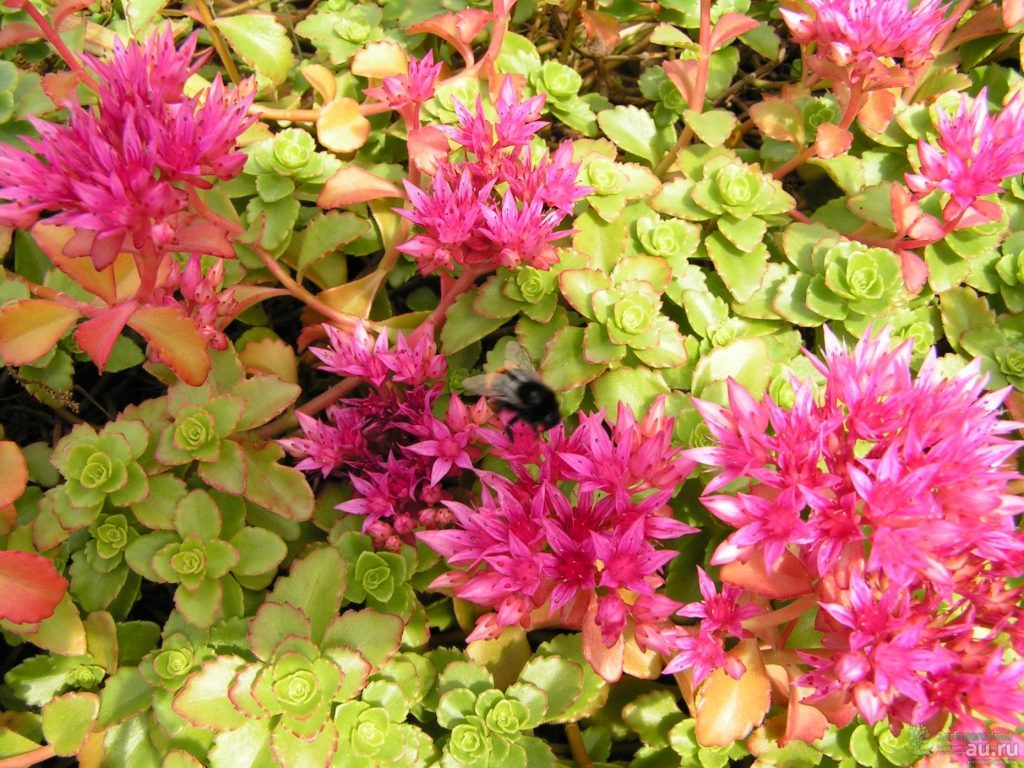
Sedum false crimson
Description of the plant
Sedum, or sedum, is a perennial herb. It belongs to the number of succulents of the Tolstyankov family. In the wild, it grows in Turkey, western Iran and the Caucasus. Also found in Russia and Eastern Europe. It prefers to grow in desert areas and on rocky soil.
The flower was discovered in the 19th century by the German botanist Friedrich von Bieberstein, who gave the plant a peculiar name. There is no specific data on the reason for this choice. However, there is an opinion that the name of the culture was given because, even in a cut form, it does not look natural.
Also, Sedum False is often called two-row, which is associated with the arrangement of leaf plates on the shoots in 2 rows. The leaves are fleshy with jagged tops and a blunt base, painted in a rich green color, have a cream edging, which, under the influence of the sun, changes its hue to ruby red. They reach 3 cm in length with a maximum width of 1 cm.
The plant itself is squat, growing in the form of a bush up to 25 cm high. Vegetative processes mainly spread over the surface of the substrate; varieties with erect segments are also found.
It blooms profusely, with small corymbose inflorescences, the color range of which is often pink, less often purple or red. Not surrounded by upper leaves as seen in most Sedums. The flowering phase lasts a long time, up to 2.5 months. Begins from June to July, depending on the region of growth.
The fruit forms oblong, egg-like, inside which there are small seeds, characterized by excellent germination. At the onset of the cold season, the flower is completely bare, shedding foliage.
Varieties
All types of false sedum are united by the generic name - Sedum spurium. Consider the features of each.
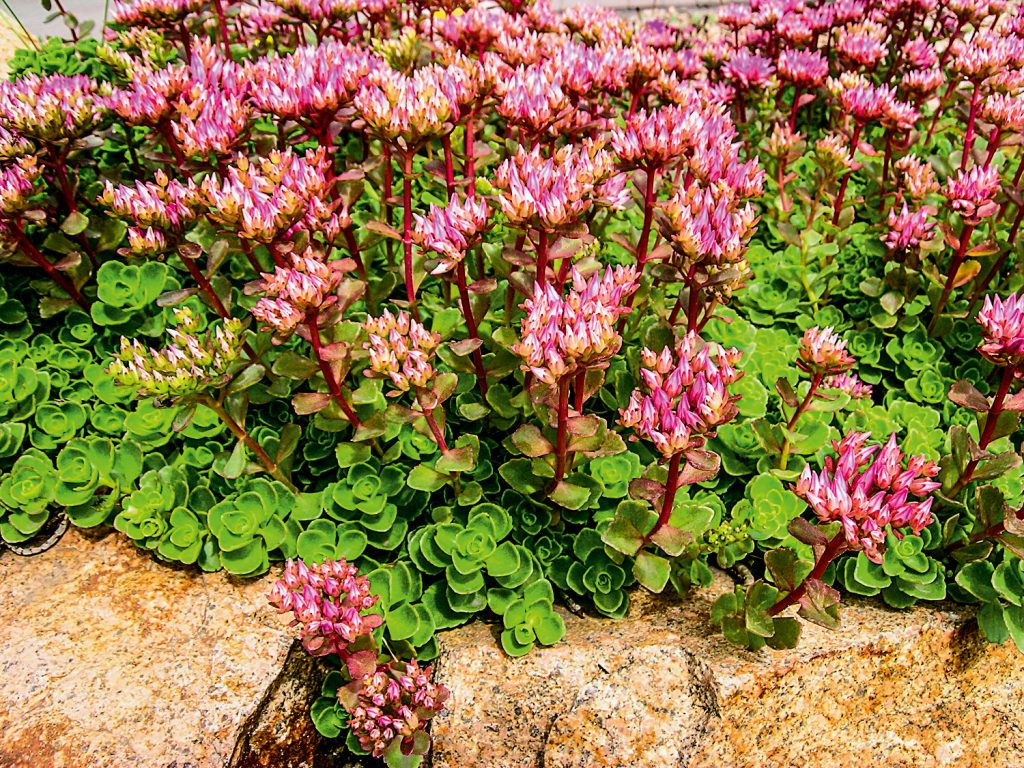
Sedum false landing and leaving
Tricolor
The second name of the plant is Variegatum.
Sufficiently compact and dense bush. Grows up to 35 cm in height. The structure of the leaves is typical for Sedum, a light green shade with a white or pinkish border. Inflorescences are pink, umbrella type.
Roseum
Flowering shoots can reach a height of 25 cm, small pointed pink buds are formed on the tops in July-August. On the stems there are fleshy leaves of a deep green color with slightly blunt teeth along the border.
Purple carpet
Sedum "Purple Carpet" is a squat ground cover shrub, the maximum height of which does not exceed 20 cm. The stems are highly leafy, forming a crown with a diameter of 40-50 cm. The leaf blades are bright green.
The inflorescences are dense, combining in tandem several purple buds, sometimes with a carmine tint.
Dragons blood
A very colorful description of the type of Sedum, which justifies its name by a change in external characteristics with the onset of autumn.
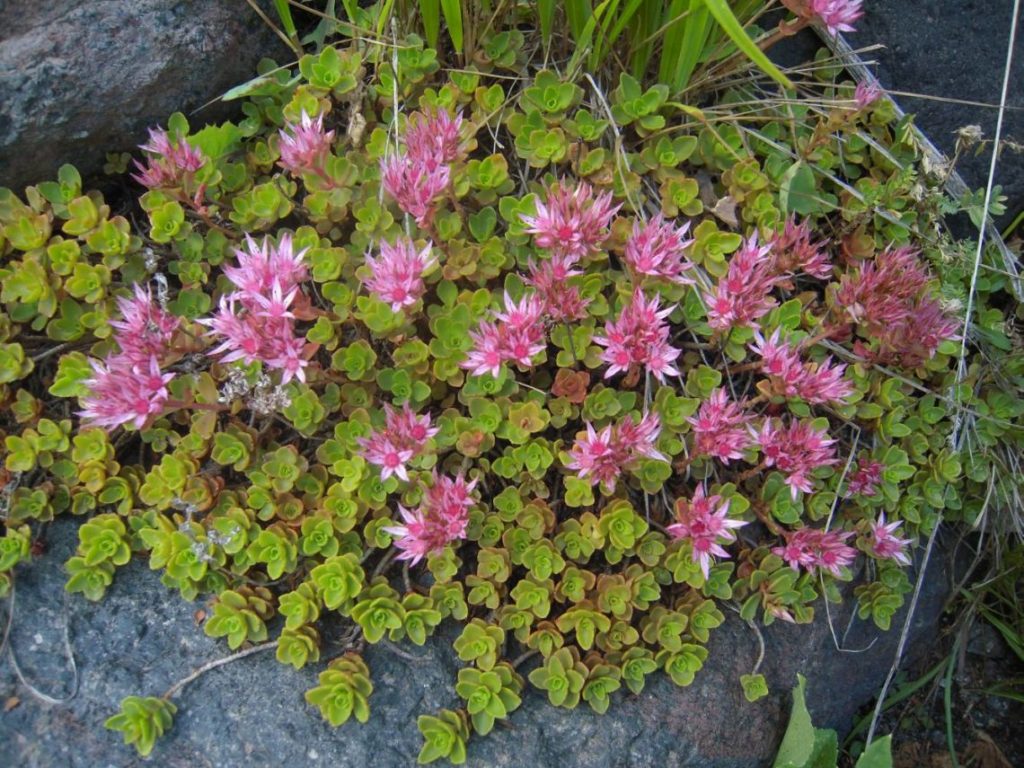
Sedum false blush
In the growing season, the leaves of the culture are green with a crimson outline; over time, the blush spreads over the entire surface.
Voodoo
Groundcover succulent with glossy burgundy-colored leaves. It is characterized by juicy shoots, low up to 6 cm, rising above the ground and forming a dense carpet. Peduncles grow up to 15 cm in height. It is considered one of the most hardy varieties of Sedum due to the presence of adventitious roots located at the base of the processes.
Albiflorum
Forms a cover with a maximum shoot height of 20 cm. The leaf plates are light green. It blooms with white flowers from May to June.
Fuldaglut
The stems of the variety spread or rise slightly above the surface of the ground up to 6 cm in height. The length of the peduncles varies from 6 to 25 cm. The buds form pink or purple from July to August.
Purchase and adaptation
It is best to buy succulent seedlings in specialized nurseries, which guarantees the quality of the plant. In this case, the seedling should be carefully examined so that there are no blotches of excellent tone on it, and the leaves have a healthy fresh appearance.
If you plan to grow a flower at home, then for 20 days it is isolated from other green pets, which allows you to initiate possible pests and diseases.
The necessary conditions
Growing such an unpretentious succulent outdoors is not particularly difficult. The culture is considered hardy and is able to winter without loss even during severe cold weather.
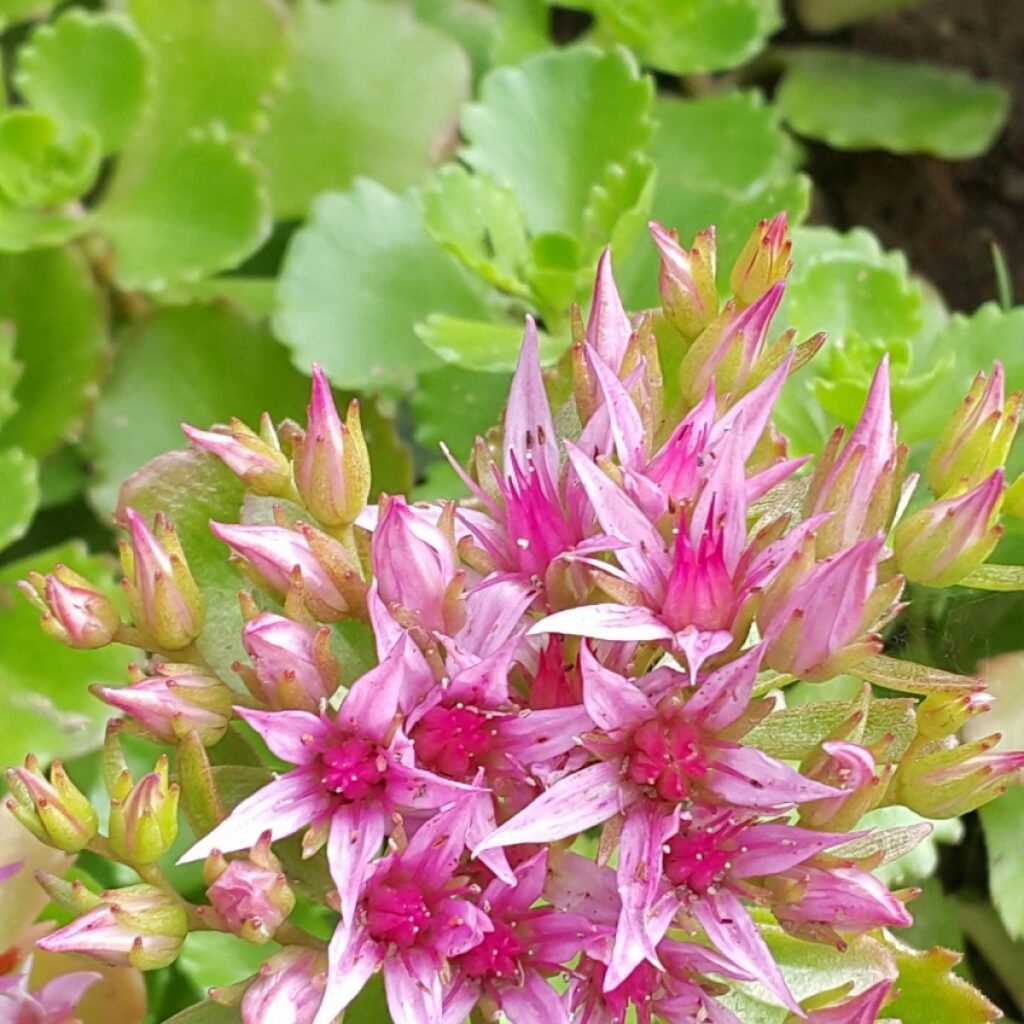
Sedum false roseum
Temperature
If the ground cover shrub is cultivated on street plantings, it easily adapts to temperature fluctuations and does not need to be covered with spruce branches or other insulation for the winter.
When grown at home Sedum during the growing season is kept at 18-20 ° C, during the dormant period the temperature is reduced to 10-14 ° C.
Lighting
It needs the brightest possible lighting, it is not particularly located even to the diffused rays of the sun. In this regard, at home, if necessary, the plant is illuminated with phytolamps.
If the flower is deficient in light, the flowering will be more scarce, and the leaves of varieties with a raspberry color will acquire a green tint and lose their decorative effect.
Humidity
There is no need to purposefully increase air humidity, the crop feels quite comfortable without spraying, regardless of climatic conditions.
Sanitary cleaning is allowed by means of a light shower in order to eliminate the dirt that has settled after the winter from the sheet plates.
Landing rules
When planting a plant in a new place, it is worth considering the characteristics of its root system - the roots are located superficially.
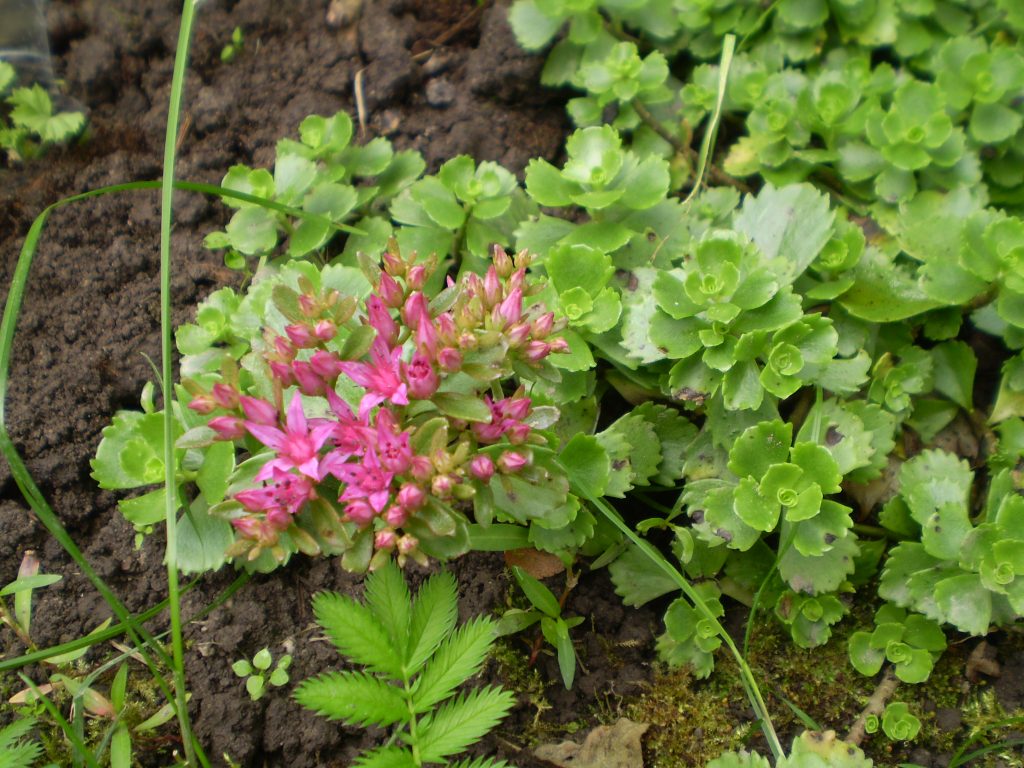
Sedum false tricolor
During the event, a small depression is made in the ground, where the bush is placed - so that the root collar is not buried. Top up with earth, lightly crush, watered.
The optimal time for agrotechnical work is the beginning of the growing season, spring.
When growing in an apartment, there are no time limits. The sedum takes root well.
Site and soil selection
Compared to its fellow succulents, the sedum plant is picky about the composition of the soil and feels best in fertile garden soil.
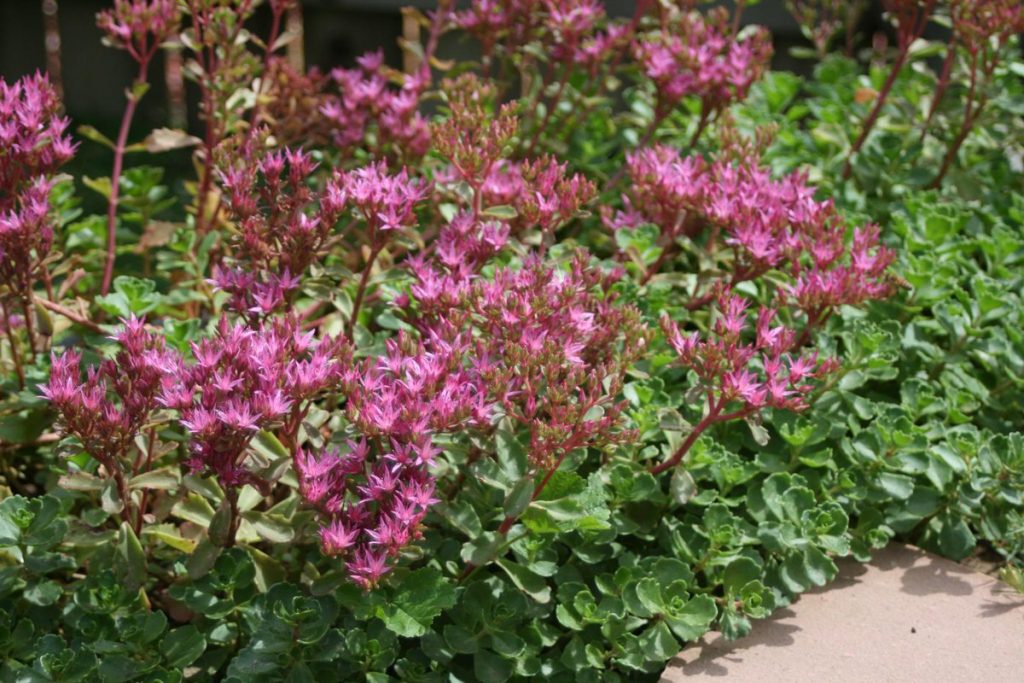
Sedum spurium
The main conditions for the soil mixture:
- high degree of aeration and water permeability;
- the presence of a drainage layer (crushed stone or chipped brick is used as materials);
- loose structure.
Optimal composition:
- river sand (1 part);
- peat land (1 part);
- turf (1 part);
- compost / vegetable humus (1 part);
- lime (½ part).
When choosing a location, you should give preference to an area not shaded by garden plantings and buildings.
If the culture is kept at home, the pot is placed on a windowsill with an orientation to the South, South-East or South-West.
Care
A particular difficulty in caring for a False Scrubber lies in wait for flower growers in the first month after planting a crop in a flower garden.
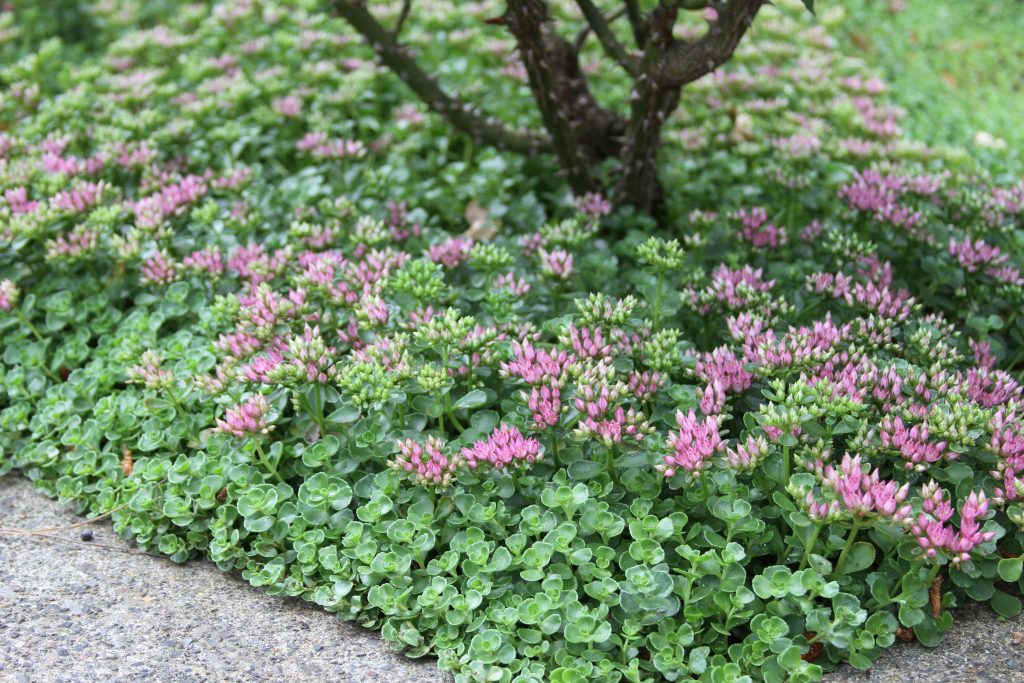
Sedum spurium
This is due to the low resistance of the shrub to various weeds. At the initial stage, you will have to carefully weed the beds to give the succulent the opportunity to adapt in a new place.
Watering
Due to the high liquid content in the shoots and fleshy leaf plates, watering is carried out moderately. In especially hot months, the soil is moistened once a week, while trying not to get on the green part of the plant.
If the region is characterized by frequent rains and the temperature does not exceed 25 ° C, the procedure is not carried out.
At home, irrigation during the dormant period is minimized (up to 1 time per month) and is done by filling water into the sump, almost immediately removing its excess from the container.
Top dressing
To ensure abundant flowering, it is recommended to feed the plant at the initial stage of the growing season with organic fertilizers of low concentration (the best option is horse manure) or phosphorus-potassium preparations. It is impossible to overdo it in this matter - the succulent reacts extremely sensitively to nitrates, as a result of which it can grow and greatly change.
Also, from an excess of introduced nutrients, the risk of a decrease in frost resistance and immunity to various diseases and pests increases.
Transfer
Often, fragile leaves snap off at Sedum and, as a result, the shoots are exposed, in this regard, a transplant is required every 1 or 2 years, provided that it is grown at home.
To solve a similar problem in representatives of this species, cultivated in the open air, you can sprinkle the necessary areas with earth, after bending them to the surface.
Pruning
To maintain decorativeness, it is necessary to regularly cut off faded buds, as well as remove dry and injured segments after wintering. Such actions stimulate the laying of new inflorescences and shoots. During the cleaning procedure, you cannot cut the stems under the base, it is important to leave productive growth points.
Reproduction methods
By cuttings
Often this method is used in parallel with a rejuvenating haircut, when the apical shoots are cut to increase the decorative qualities. The material is taken only from adult specimens that have reached 4-5 years old. The procedure is carried out before the beginning of the flowering stage or after it.
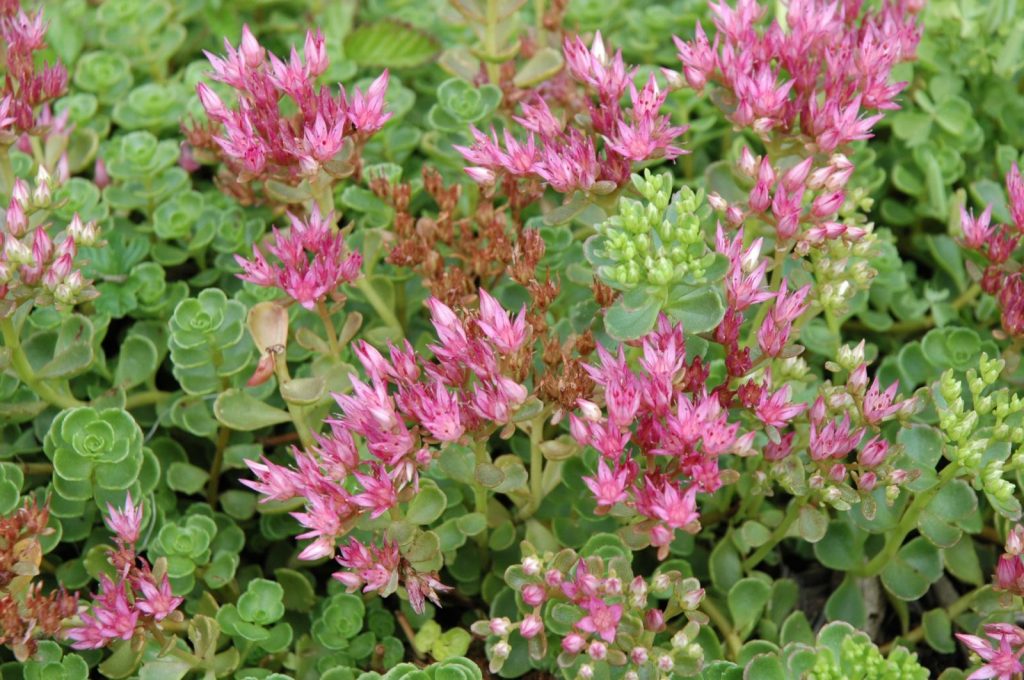
Sedum false variegatum
Process technology:
- The upper part of the shoot is 5-7 cm long.
- The base of the cutting is cleaned from the leaves.
- The shoots are inserted into the ready-made substrate immediately in the open ground, if the weather permits, or into a container. The soil is moistened, preventing overflow. For faster rooting, the knot is deepened on the stem.
- After 2-3 weeks, when 2-3 new leaves are formed on the handle, a pick is made.
Seeds
Sedum blooms for a long time, it is quite easy to collect seeds. Thanks to their excellent germination, it is possible to get good seedlings, the sowing of which is carried out both in March-April, and immediately in a flower bed before winter.
Seeding principle:
- A suitable substrate is poured into the prepared containers.
- Without deepening, the seeds are distributed over the surface.
- Moisten the soil with a spray bottle. It is not worth using a watering can, a stream of liquid will deepen the material into the ground, as a result, the germination of seedlings will deteriorate.
- Cover the container with film or glass to create a greenhouse effect. They are moved to a place with a constant temperature of 6-8 degrees, in which the seedlings are kept for 10 days. After the specified time, they are transferred to a room with standard indicators for apartments.
- Regularly ventilate the greenhouse and moisten the ground with a sprayer.
- After the appearance of several true leaves, they dive. They move to open ground in May, maintaining a distance between seedlings of 10-15 cm.
By dividing the bush
The simplest method to obtain new specimens is carried out in the spring or in October after the flowering stage. For this, the mother bush is carefully dug out of the ground and divided into the required amount. At the same time, a part of the root system and young shoots are left on each plot.
Diseases and pests
The plant is characterized by high disease resistance and is rarely attacked by pests. Such diagnoses are more of an exception to the rule, but require immediate intervention from the grower.
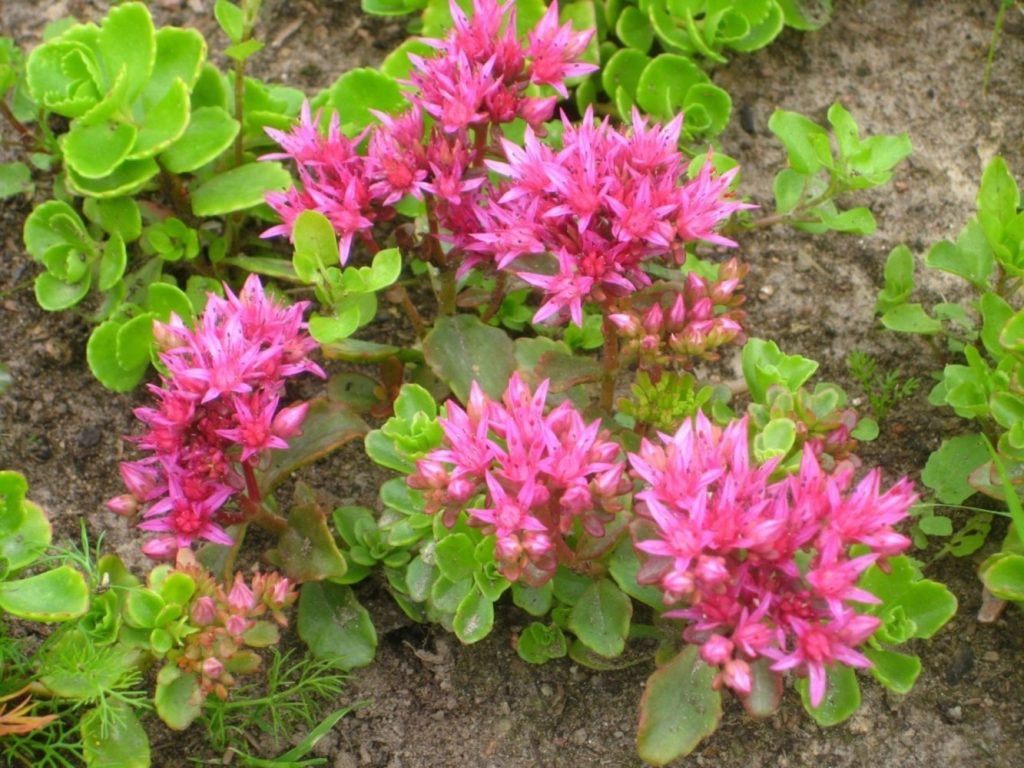
Sedum false fuldaglut
Pests and rules for dealing with them. Table # 1.
| Insect | Signs | Solution to the problem |
| Nematodes | Yellow spots appear on the surface, which eventually turn brown or black. Leaves become smaller, deformed, fall off. A suspension of plant development is observed, the shoots are bent. | Prevention:
Ways to fight:
Soil treatment with Decaris solution with the calculation of 1 tablet per 1 liter of water. |
| Thrips | Small light spots that increase in size over time. Dying off of tissues, loss of turgor by leaves, shedding, curvature of stems. The flowers are deformed. | Prevention:
Ways to fight:
|
| Aphid | Leaves curl and turn yellow, nodules are formed, stems and buds are modified. | Prevention:
Ways to fight:
|
Diseases and methods of their treatment are presented in table №2.
| Name | Symptoms | Treatment |
| Powdery mildew | The appearance is associated with the development of a harmful mycelium. Initiated by a white powdery coating. Leaves wither, fall off. | Prevention: Spray with Quick or Topaz. Damaged segments are removed regularly. Treatment: They are treated with fungicides: Cumulus, Tissot Jet, colloidal sulfur. |
| Fungal infection | Dark spots on the surface | Damaged areas are stopped and burned. |

